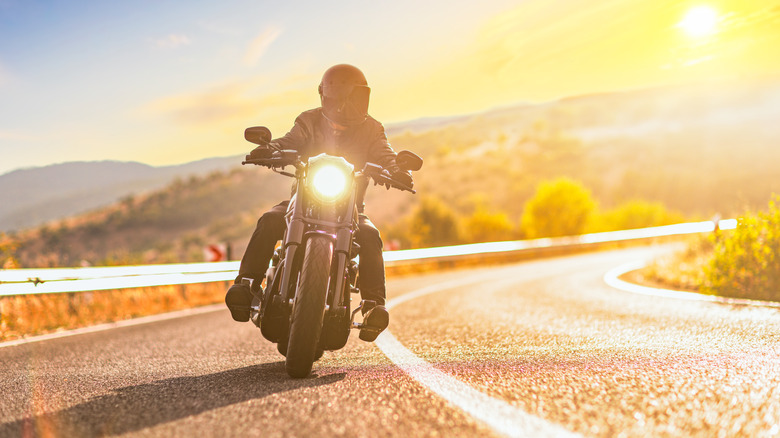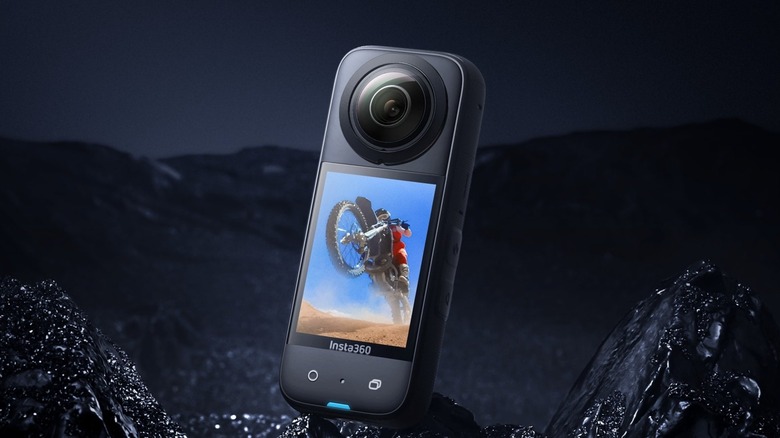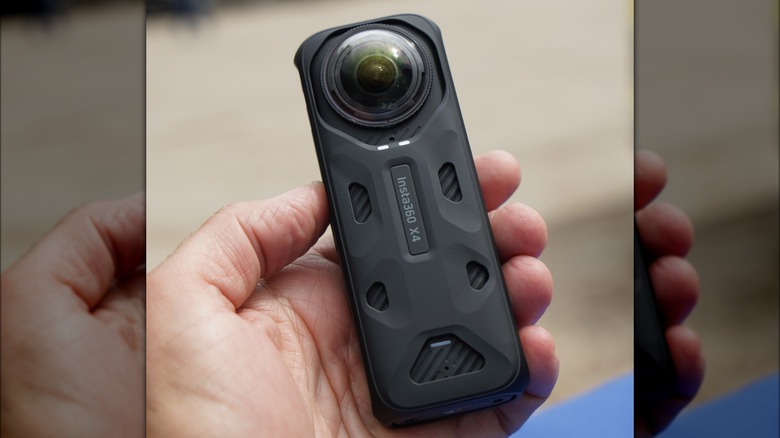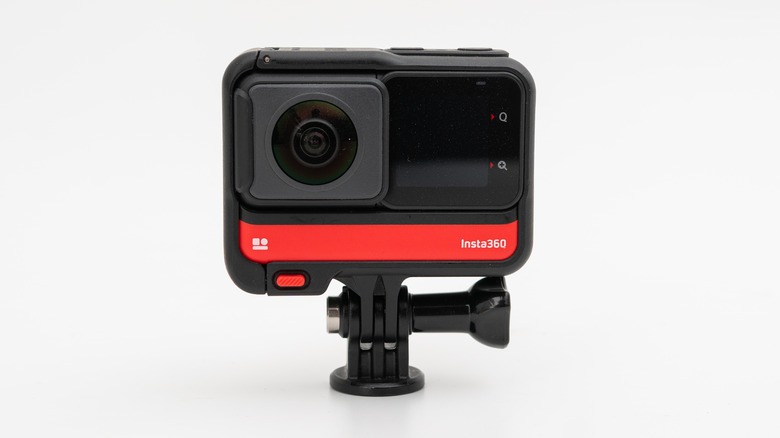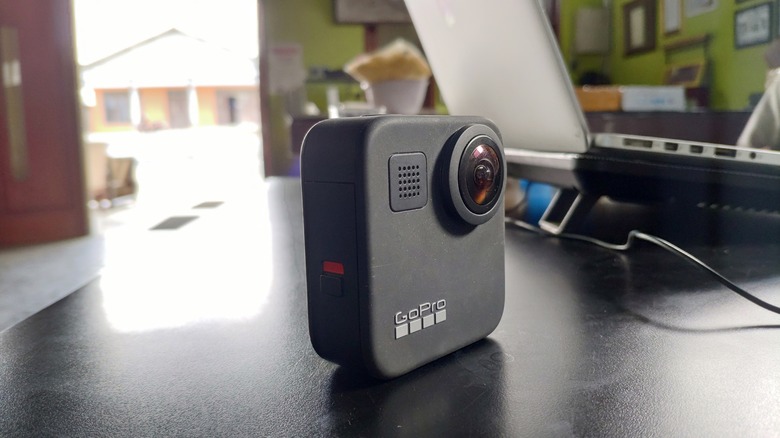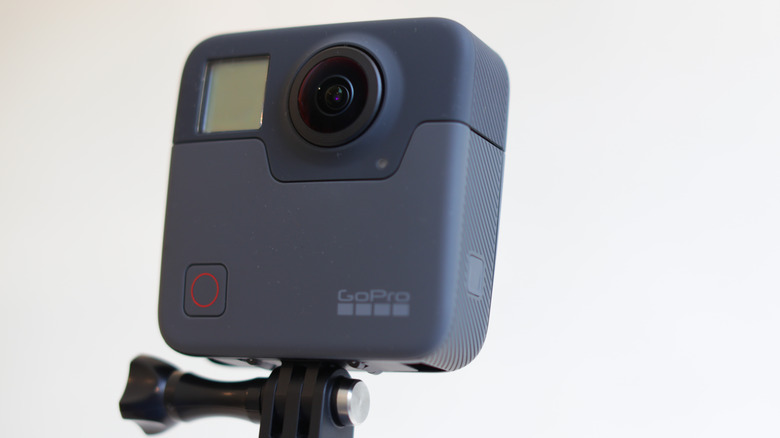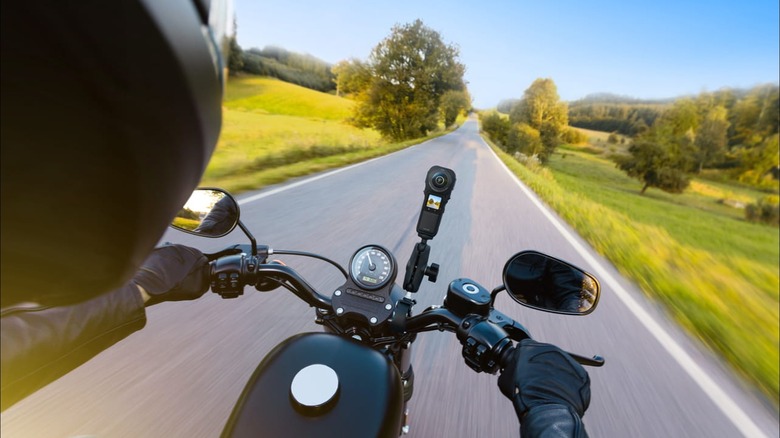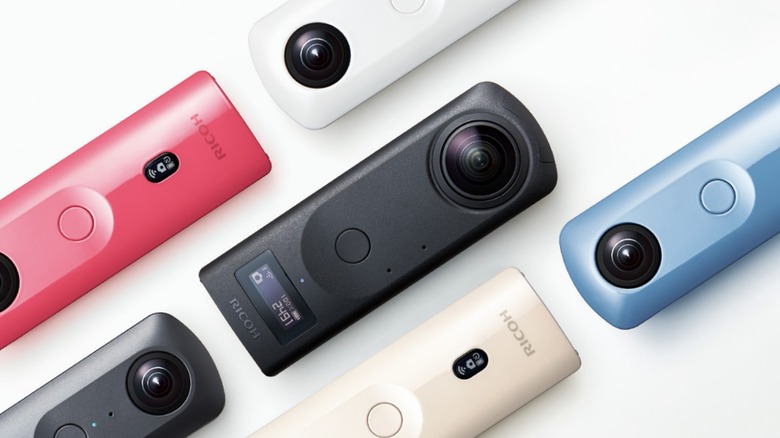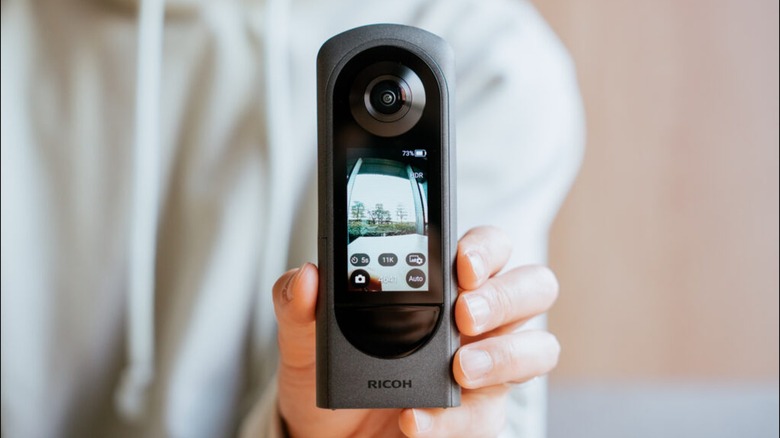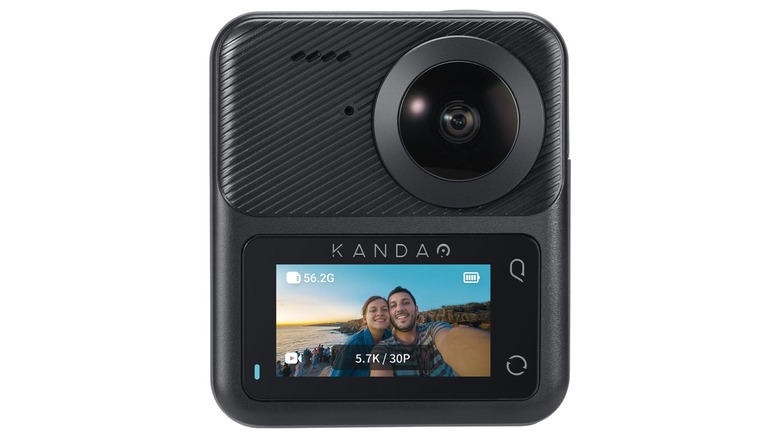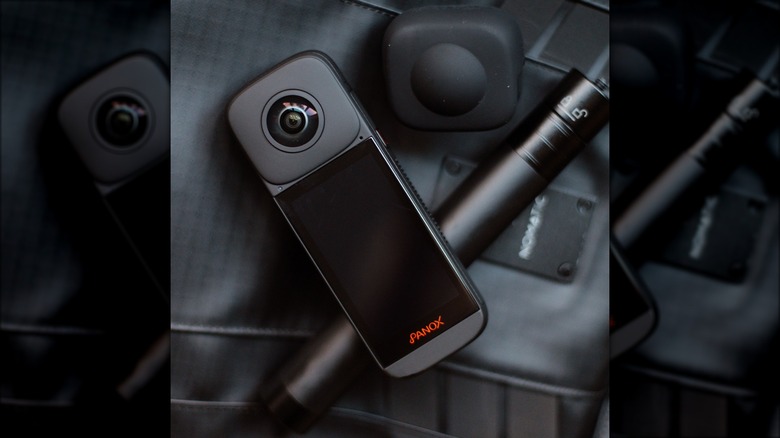10 Highly-Rated 360 Cameras For Motorcycles
We may receive a commission on purchases made from links.
Who doesn't love a good motorcycle? Few sensations are as exhilarating as speeding down a road on one, but motorcycles aren't for everyone. Some people are too daunted by the balance and concentration needed to properly ride a motorcycle, especially at high speeds when the adrenaline hits. Thanks to technological advances, skilled motorcyclists can share a facsimile of what it's like to use a motorcycle with people who don't care to ride.
As its name suggests, a 360 camera can record video and take pictures in a full 360 degrees. Most 360 cameras achieve this feat with multiple lenses; each camera records a view, and internal software stitches them all together to create a single shot. From there, the user can zoom in on a section to create a picture or video similar to ones created by normal cameras, zoom out until the entire image is a nauseous fisheye, or turn the 360 recording into a VR experience.
Since motorcycles rarely give smooth rides, anyone who wants to record a 360 video of their bike will have to find a way to secure it; using just a selfie stick is asking for the camera to fall onto pavement. Moreover, the camera needs to be robust enough to record landscapes passing by at high speeds. If you own a motorcycle and want to share your riding experiences, consider buying one of these ten cameras, organized in no particular order.
Insta360 X3
The Insta360 is currently the premier brand of 360 cameras and general action cameras. The company's first physical product was the Insta360 One, which was followed up by the Insta360 One X and One X2. The successors to this line dropped the "One" but kept the "X" in their names.
Released in 2022, the Insta360 X3 was widely regarded as one of the best 360 cameras on the market. This small-form device boasts two cameras that can record images of up to 72 megapixels (72 million pixels). Every video by the Insta360 X3 is powered by the AI-powered Insta360 app, which lets users record in the moment and pick their preferred viewing angles later.
One of the Insta360 X3's best features is its Me mode, which automatically deletes the selfie stick from all recorded videos. It's like watching recordings of yourself from a third-person camera in a video game, but how does one use a selfie stick while riding a motorcycle? The answer: with one of Insta360's motorcycle bundles. Buyers can securely fasten the camera to handlebars or a U-bolt, and extend the vantage point with a smart-deleting selfie stick. Plus, each bundle comes with lens caps to protect the lenses, as well as a free water bottle. Hydration is important, even when on a motorcycle.
Insta360 X4
Since 2022, the Insta360 X3 has been the top choice of many 360-camera aficionados. However, it was only a matter of time before the company released a successor. The X3 might be a great camera, but the Insta360 X4 is just plain better.
The Insta360 X4's most noteworthy upgrade is its resolution. While the X3 captures action in up to 4K, the X4 raises the ante to 8K resolution at 60 FPS, while in 360 capture mode no less. Additionally, the Insta360 X4 introduces a wind reduction feature that filters out the noise of wind rushing by — a must for anyone barreling down roads at high speeds. We can't forget that the X4 boasts a larger screen, a more powerful battery than the X3's, and the ability to start recording when connected to an external power source.
While the Insta360 X4 improves on the X3 in many ways, it doesn't abandon any of the features that make it ideal for motorcycling videos. Like the X3, the X4 automatically stabilizes every recording for smoother videos; not even a full 360-degree flip disrupts the camera's focus on the horizon. The X4 also automatically removes selfie sticks from videos, is waterproof, and connects to the Insta360 app. Moreover, the Insta360 X4 is compatible with all the motorcycle mounting bundles that work with the Insta360 X3, so anyone who purchased the X3 and wants to upgrade to the X4 doesn't have to spend extra money on a second motorcycle mount.
Insta360 One RS
As previously stated, the Insta360 One spun off into the Insta360 X series, but the Insta360 One still survives as its own line of 360 cameras that are a bit more budget-friendly than the Insta360 X.
The Insta360 One RS is an action camera (i.e., a non-360 camera designed for extreme sports) that can convert into a 360 by swapping out a lens attachment. At its base capabilities, the One RS can capture images with up to 48 megapixels and in 6K widescreen. With the second 360 lens, the Insta360 One RS can capture motorcycle action in 5.7K. Regardless of the lens, the One RS boasts the same stability, HDR, slow-mo recording mode, and Insta360 app functionality as the Insta360 X family.
As an action camera, the Insta360 One RS is uniquely equipped to record videos of motorcycle rides. Some of the camera's features include noise reduction that lets riders capture more than just the roar of the engine and a special mounting bracket that keeps the camera cool during recording sessions. Moreover, the One RS is compatible with numerous attachments designed for motorcycles. Like the Insta360 X series, the One RS can delete selfie sticks from videos, so anyone who wants to see themselves ride a motorcycle in the third person can set up this 360-hybrid camera to capture just that.
GoPro Max
GoPro effectively catalyzed the general populace's interest in action cameras. The company made a name for itself with rugged devices that can record extreme sports such as biking, parkour, and motorcycling while in the thick of the action. While GoPro is mostly known for its action cameras, it still manufactures worthwhile 360 cameras.
Like the Insta360 cameras, GoPro Max records a full 360 degrees worth of images and videos by utilizing two widescreen cameras at once and stitching their captures together. The Max can record videos in up to 6K resolution, and users can edit them via an app to change image framing and get optimal pictures. Like the Insta360s, the GoPro Max has its own stabilization and horizon lock technology to keep videos smooth and trained on the skyline, which is necessary when landscapes speed up during motorcycle rides.
All GoPros are designed with modularity in mind, so the GoPro Max is compatible with every GoPro mounting accessory. This lets users attach the camera to a variety of points on motorcycles. The GoPro Max can also render its selfie sticks invisible during third-person perspective videos, but that's not all it can do. The Max also utilizes voice recognition features and can live stream videos. The only thing better than posting a clip of a motorcycle ride online is taking audiences along for the ride in real time.
GoPro Fusion
While the GoPro Max is the company's premier 360 camera, it wasn't the first. GoPro entered the 360 video market in 2017 with the GoPro Fusion. Despite almost being a decade old, the GoPro Fusion still holds up, assuming you can find one.
As the predecessor to the GoPro Max, the GoPro Fusion shares many functional similarities. The Fusion records on two cameras and uses "gimbal-like stabilization" to smooth out recordings and cut out jerky actions. Plus, the GoPro Fusion employs its own smartphone program so users can pick perspectives from recordings. Without that program, we might not have the GoPro Max's app.
Like other GoPros, the Max is compatible with all available GoPro attachment accessories, so it can easily slip onto any motorcycle mount and stay there. However, since the Fusion is the Max's predecessor, it isn't quite as advanced. For instance, while the GoPro Max's two cameras scribble all of their data onto one SD card, the GoPro Fusion requires two — one for each lens. Plus, the Fusion lacks the Max's ease-of-use capabilities, which include its touchscreen, voice activation, and streaming. On the bright side, if you can find a Fusion, it will almost always be more wallet-friendly than the Max.
Insta360 One RS 1-Inch Edition
Since the 360 lens attachment is optional for the Insta360 One RS, the device is an action camera first and a 360 camera second. Several months after Insta360 released that device, the company reinvented it with the RS 1-inch Edition.
The Insta360 One RS 1-Inch Edition was co-designed with the German camera company Leica, and despite what the camera's name might suggest, it isn't a smaller version of the Insta360 One RS. The "1-Inch Edition" part of the name comes from its one-inch complementary metal oxide semiconductor (CMOS) sensors, which are more efficient and provide better images than traditional camera semiconductor sensors. While the One RS 1-Inch Edition can only snap images at 21 megapixels, it can still capture 360 video in 6K resolution. Aesthetically, the 1-Inch Edition drops the original blocky action camera layout for the traditional thinner 360 camera design.
Like every other Insta360 device on the market, the One RS 1-Inch Edition features motion stability, horizon lock, selfie stick invisibility, and Insta360 app functionality that customers and motorcyclists rely on. While the Insta360 One RS 1-Inch Edition looks vastly different from the standard One RS, both are built around the "One RS Core," which means the 1-Inch Edition is fully compatible with the motorcycle bundle and other Insta360 extreme sports mounts.
Ricoh Theta Z1
While 360 cameras are spectacular devices that let adventurous people share their escapades from numerous angles, one can't help but wonder who introduced the first commercially available one. Insta360 and GoPro sound like reasonable assumptions, but the true answer is the Japanese company Ricoh Imaging.
The Ricoh Theta Z1 is Ricoh Imaging's top-of-the-line 360 camera and has been going strong since it launched in 2019. The Z1 can capture high-def 360 images in 23 megapixels, and its videos can go as high as 4K resolution at 30 FPS. Unlike most of its competition, this camera utilizes CMOS sensors for superior image noise canceling, and the Theta Z1 also features a robust image stitching program that can save images in multiple formats and work seamlessly with Adobe Photoshop. Like the GoPro Max, the Ricoh Theta Z1 is capable of livestreaming.
While Ricoh Imaging doesn't sell any dedicated motorcycle accessories for the Ricoh Theta Z1, the camera can securely fasten to a vehicle with the right attachments. On the surface, this shortcoming makes the Ricoh Theta Z1 sound like it isn't designed for motorcycles, but the camera shell is made out of a robust and durable magnesium alloy construction that can take a serious impact without much trouble. Still, we can't forget that the Theta Z1 utilizes big, friendly buttons that are easy to use while wearing motorcycling gloves or that one of these buttons lets users easily cycle through shooting modes on the go.
Ricoh Theta X
Like many companies in the action and 360 camera business, Ricoh Imaging sells the Theta Z1 alongside its successor, the Theta X. The Theta X has all of the improvements one would expect from the next entry in the Ricoh Theta line, as well as some unexpected additions.
The Ricoh Theta X might not be bigger than the Theta Z1, but it is definitely better than the Theta Z1. The Z1's 23-megapixel camera has been upgraded to an impressive 60 megapixels, and its 4K video resolution has given way to 5.7K. Moreover, the Theta X features numerous social media sharing tools so users can upload their 360 images and videos directly to sites such as Facebook, Instagram, and Twitter. The Theta X also includes a built-in GPS, so motorcyclists and shutterbugs alike can embed coordinates to their content in case any viewers want to know precisely where they can find the best vistas from a motorcycling livestream.
While the Theta X is vastly superior to the Theta Z1 in terms of recording quality, it doesn't sacrifice anything in terms of usability or motorcycle compatibility. The Theta X still secures its innards within a durable magnesium alloy shell, and even though it's more powerful than the Z1, the X is actually lighter than its predecessor. Not by much, but enough to help crank out a bit more power in a motorcycle engine. Besides these changes, the Ricoh Theta X can use all the motorcycle mounts as the Theta Z1.
KanDao QooCam 3
Some companies, such as Insta360 and GoPro, deal exclusively in 360 and action cameras. However, companies such as KanDao cast a wider net with cameras that fulfill different purposes, including capturing motorcycle trips in all their 360 splendor.
The KanDao QooCam 3, aside from being a mouthful of a name, is a well-rounded camera with all the features 360 camera fans have come to expect from these devices. These include 5.7K resolution video, 62-megapixel 360 images, wind noise reduction, and excellent image stabilization. However, these are far from the QooCam 3's only features. The camera also provides superior low-light imaging — perfect for people who prefer motorcycling under moonlight — and four microphones that translate into spatial audio for recorded videos. Users can also upgrade to the KanDao QooCam 3 Ultra for 8K video, 96-megapixel pictures, and GPS coordinate embedding.
Like the Insta360 and GoPro, KanDao sells a dedicated motorcycle kit for the QooCam 3, and while the QooCam 3 Ultra isn't sold with one, that camera is still compatible with all those mounting accessories. The bundle includes a series of motorcycle mounts to securely fasten the camera to a bike, a selfie stick to create third-person clips (the QooCam 3's software renders the stick invisible in videos), and an extra battery so the camera doesn't run out of juice halfway through a trip. The bundle includes so many mounting points and batteries one could use two QooCam 3s at once, or a QooCam 3 and a QooCam 3 Ultra.
Panox V2
Every company behind a 360 camera has an origin story. GoPro, for instance, was founded because its CEO Nick Woodsman was surfing in Australia and wanted to take high-quality photos of himself hanging 10, but he was disappointed by the lack of inexpensive quality cameras. Then there's Panox, a company that spun out of Hong Kong University students creating embedded panoramic algorithms.
The Panox V2 is Panox's leading 360 camera. The website states the device is designed for vlogging, but that's just a catch-all for anything shutterbugs and content creators can imagine, including motorcycling. The Panox V2 boasts some impressive specs, including 5.7K resolution 360 videos (admittedly at 30 FPS), a comparatively massive three-inch touchscreen, and 72-megapixel 360 photography.
While the Panox V2 is built with general vlogging in mind, it sports many features that help motorcycle enthusiasts create the best content possible. For instance, the camera can livestream 360 videos to Facebook and YouTube in 4K, and it can also tag locations via GPS and create custom Google Street View images. Plus, if a motorcyclist wants to just pause and take in the scenery, the Panox V2 lets them capture a 360-timelapse video. Regarding accessories, the Panox V2 works well with either a dedicated helmet or motorcycle mount.
